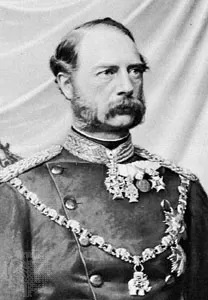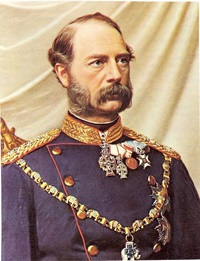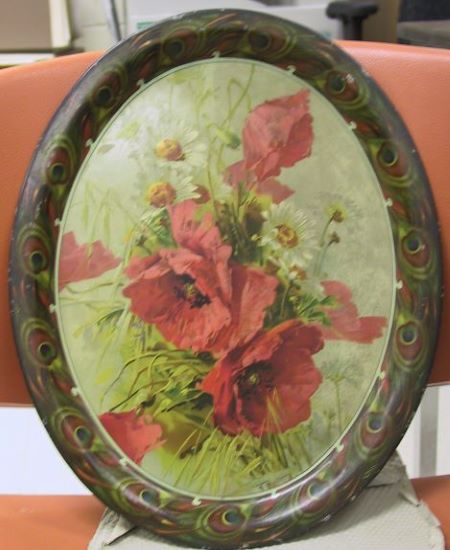The 'Stock' Exchange
H.D. Beach Co. No. 17-B - Poppies
H.D. Beach Co. No. 17-B - Poppies
Date: 1906 - 1908
Size: 13.5" x 16.5"
Type: Inverted Pie
Scarcity: Hard to Find
Value: $$$ to $$$$
Condition & Brewer Dependent
Size: 13.5" x 16.5"
Type: Inverted Pie
Scarcity: Hard to Find
Value: $$$ to $$$$
Condition & Brewer Dependent


Confirmed Brewer used Stock Trays
Non-Beer Related & Non-Tray Uses
General Comments
We hadn’t ever really given this design much thought before the whole effort with this site; after all, it’s just a basic image (more basic than most) of some red flowers, right? But one of the consequences of our efforts here has been to really examine each design more closely and actually think about what it might represent. Admittedly, we’ve had to engage in a certain degree of assumption, educated guesses, and even speculation, backed up by some degree of research effort. This simple design ended up surprising us quiet a bit, although we readily admit we are well into the realm of theory and speculation. Hang with us here, it’s a bit of a wild ride.
The focal point of the design are the red poppies, which draw the eye with their size and color, overshadowing the accompanying daisies. So much so that we really didn’t even notice them initially. While there is some association of the poppy with drug culture due to its use in the production of heroin and morphine, red poppies in particular also have widely come to symbolize death and remembrance following the brutal trench warfare in the poppy fields of Flanders, Belgium during World War I. Poppies have long been used as a symbol of sleep, peace, and death: Sleep because the opium extracted from them is a sedative, and death because of the common blood-red color of the red poppy in particular. In Greek and Roman myths, poppies were used as offerings to the dead. Poppies used as emblems on tombstones symbolize eternal sleep. This symbolism was evoked in L. Frank Baum's 1900 children's novel The Wonderful Wizard of Oz, in which a magical poppy field threatened to make the protagonists sleep forever.
Daisies symbolize innocence and purity. This stems from an old Celtic legend that whenever an infant died, God sprinkled daisies over the earth to cheer the parents up. In Norse mythology, the daisy is the goddess Freya’s sacred flower. Freya is the goddess of love, beauty, and fertility, and as such the daisy came by symbolize childbirth, motherhood, and new beginnings. Daisies are sometimes given to congratulate new mothers. So what an odd combination with the death and remembrance symbolism of the red poppies.
The third element of the overall design is the unique, peacock feather rim design. Peacocks and peacock feather have a number of symbolic interpretations (beauty, immortality, holiness, renewal and purity), but they are also associated with royalty. Putting this together with death and remembrance symbolism of the poppies, and the innocence of the daisies, we wondered if perhaps there was a significant death of a minor child from one of Europe’s royal households that the design was meant to represent.
We hadn’t ever really given this design much thought before the whole effort with this site; after all, it’s just a basic image (more basic than most) of some red flowers, right? But one of the consequences of our efforts here has been to really examine each design more closely and actually think about what it might represent. Admittedly, we’ve had to engage in a certain degree of assumption, educated guesses, and even speculation, backed up by some degree of research effort. This simple design ended up surprising us quiet a bit, although we readily admit we are well into the realm of theory and speculation. Hang with us here, it’s a bit of a wild ride.
The focal point of the design are the red poppies, which draw the eye with their size and color, overshadowing the accompanying daisies. So much so that we really didn’t even notice them initially. While there is some association of the poppy with drug culture due to its use in the production of heroin and morphine, red poppies in particular also have widely come to symbolize death and remembrance following the brutal trench warfare in the poppy fields of Flanders, Belgium during World War I. Poppies have long been used as a symbol of sleep, peace, and death: Sleep because the opium extracted from them is a sedative, and death because of the common blood-red color of the red poppy in particular. In Greek and Roman myths, poppies were used as offerings to the dead. Poppies used as emblems on tombstones symbolize eternal sleep. This symbolism was evoked in L. Frank Baum's 1900 children's novel The Wonderful Wizard of Oz, in which a magical poppy field threatened to make the protagonists sleep forever.
Daisies symbolize innocence and purity. This stems from an old Celtic legend that whenever an infant died, God sprinkled daisies over the earth to cheer the parents up. In Norse mythology, the daisy is the goddess Freya’s sacred flower. Freya is the goddess of love, beauty, and fertility, and as such the daisy came by symbolize childbirth, motherhood, and new beginnings. Daisies are sometimes given to congratulate new mothers. So what an odd combination with the death and remembrance symbolism of the red poppies.
The third element of the overall design is the unique, peacock feather rim design. Peacocks and peacock feather have a number of symbolic interpretations (beauty, immortality, holiness, renewal and purity), but they are also associated with royalty. Putting this together with death and remembrance symbolism of the poppies, and the innocence of the daisies, we wondered if perhaps there was a significant death of a minor child from one of Europe’s royal households that the design was meant to represent.
Click the Picture to Return to Meek & Beach Stock Catalog Page
All fascinating, but so what? How does that make him important enough to potentially have inspired this design? It probably doesn’t. What does is his role as the “father-in-law” (or sometimes grandfather) of Europe, through the dynastic and wide-spread marriages of his sons and daughters, although in truth it was Queen Louise who was the driving force behind these marriages, eager to see her children well married. Another factor was that Denmark was not one of the Great Powers, so the other kingdoms did not fear that the balance of power in Europe would be upset by a marriage of one of its royalty to another royal house. Four of Christian's children sat on the thrones (either as monarchs or as consorts) of Denmark, Greece, the United Kingdom and Russia. In 1886 his youngest son, Valdemar, was elected as new Prince of Bulgaria by the 3rd Grand National Assembly of Bulgaria but Christian IX refused to allow prince Valdemar to receive the election.
Today, most of Europe's reigning and ex-reigning royal families are direct descendants of Christian IX, and most current European monarchs are descended from him, including Queen Margrethe II of Denmark, Queen Elizabeth II of the United Kingdom, King Philippe of Belgium, King Harald V of Norway, King Felipe VI of Spain and Grand Duke Henri of Luxembourg. The consort Prince Philip, Duke of Edinburgh, and former consort Queen Sofía of Spain are also descendants of Christian IX, as is Constantine II, the former and last King of the Hellenes, and his consort the former Queen Anne-Marie. Former King Michael I of Romania and his wife Anne were also descendants of Christian IX. So, when he died in early 1906 it was a big event in Europe and would have caught the attention of the artisan crowd in Coshocton many of whom were first- or second-generation immigrants themselves.
And you just thought this was a boring design of a rough bouquet of flowers.
Size, Shape and Message Placement
The few times we’ve seen this design it has been as a full-size oval tray with a peacock feather rim. This is the only time we’ve seen the peacock feather rim, which again did not lend itself to advertising placement. We’ve never seen an example of this design with advertising, but we imagine it would occur on the face of the tray, probably in smaller print or on the back. One of the interesting details of this design is the thin band surrounding the main image right at the base of the rim. Although the bands vary in width and color over the years, they are a pretty constant feature. The unique thing about this one is the little protrusions that occur every few inches. This is the only design (to include non-stock designs) where we can recall this occurring.
Hager & Price
The design is neither discussed nor included in Hager’s catalog; and like other Beach designs in this timeframe, we suspect he never encountered one. We have only seen a single sale for this design, which was for an excellent stock sample that achieved low triple figures.
Today, most of Europe's reigning and ex-reigning royal families are direct descendants of Christian IX, and most current European monarchs are descended from him, including Queen Margrethe II of Denmark, Queen Elizabeth II of the United Kingdom, King Philippe of Belgium, King Harald V of Norway, King Felipe VI of Spain and Grand Duke Henri of Luxembourg. The consort Prince Philip, Duke of Edinburgh, and former consort Queen Sofía of Spain are also descendants of Christian IX, as is Constantine II, the former and last King of the Hellenes, and his consort the former Queen Anne-Marie. Former King Michael I of Romania and his wife Anne were also descendants of Christian IX. So, when he died in early 1906 it was a big event in Europe and would have caught the attention of the artisan crowd in Coshocton many of whom were first- or second-generation immigrants themselves.
And you just thought this was a boring design of a rough bouquet of flowers.
Size, Shape and Message Placement
The few times we’ve seen this design it has been as a full-size oval tray with a peacock feather rim. This is the only time we’ve seen the peacock feather rim, which again did not lend itself to advertising placement. We’ve never seen an example of this design with advertising, but we imagine it would occur on the face of the tray, probably in smaller print or on the back. One of the interesting details of this design is the thin band surrounding the main image right at the base of the rim. Although the bands vary in width and color over the years, they are a pretty constant feature. The unique thing about this one is the little protrusions that occur every few inches. This is the only design (to include non-stock designs) where we can recall this occurring.
Hager & Price
The design is neither discussed nor included in Hager’s catalog; and like other Beach designs in this timeframe, we suspect he never encountered one. We have only seen a single sale for this design, which was for an excellent stock sample that achieved low triple figures.
Assuming that this design was produced in sequence, it is well enough after the only dated design from Beach (No. 11, “Friends”) that we believe this design is likely from 1906 or 1907. Our research didn’t turn up an obvious candidate for “young royal death” in that timeframe; however, it did reveal a possible older candidate: Christian IX, King of Denmark (1818 – 1906) <insert photo>. We imagine most collectors not of Danish descent are asking “Who?”. Christian IX is hardly a well-known name today and from our brief examination of his reign not especially notable as a monarch. Far more interesting is the story of his eventual elevation the throne from an indirect line and his marriage to his double second cousin (we are not sure we even understand what that means), Princess Louise of Hesse-Kassel, in 1842, after getting rejected by his first proposal attempt to the future Queen Victoria of England.
Christian IX became king due to an unlikely interplay of personal, familial, and political factors. He was from a minor branch of the House of Oldenburg and the fourth son (so he was fourth in line to his father’s dukedom following his older brothers) of the relatively poor Friedrich Wilhelm, Duke of Schleswig-Holstein-Sonderborg-Glücksburg, who was a friend of King Frederik VI. Christian’s wife, Princess Louise Caroline, was herself a descendant of King Frederik V, through her mother Charlotte. Princes Louise was the closest female relative with succession rights to Christian VIII, her maternal uncle, who succeed King Frederik VI. Because the senior House of Oldenburg was dying out (and not having any children), in 1853, according to the Act of Succession 1853, Prince Christian officially became the heir to the Danish throne, eventually becoming king in 1863. Quiet a jump from being the 4th son from a minor noble who was not even Danish (Schleswig-Holstein-Sonderborg-Glücksburg is German).
Christian IX became king due to an unlikely interplay of personal, familial, and political factors. He was from a minor branch of the House of Oldenburg and the fourth son (so he was fourth in line to his father’s dukedom following his older brothers) of the relatively poor Friedrich Wilhelm, Duke of Schleswig-Holstein-Sonderborg-Glücksburg, who was a friend of King Frederik VI. Christian’s wife, Princess Louise Caroline, was herself a descendant of King Frederik V, through her mother Charlotte. Princes Louise was the closest female relative with succession rights to Christian VIII, her maternal uncle, who succeed King Frederik VI. Because the senior House of Oldenburg was dying out (and not having any children), in 1853, according to the Act of Succession 1853, Prince Christian officially became the heir to the Danish throne, eventually becoming king in 1863. Quiet a jump from being the 4th son from a minor noble who was not even Danish (Schleswig-Holstein-Sonderborg-Glücksburg is German).




